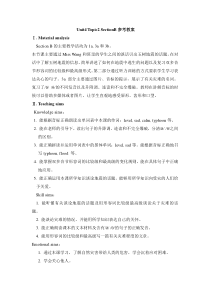 DOC
DOC
【文档说明】Unit 4 Topic 2《How can we protect ourselves from the earthquake》(SectionB)教案-八年级上册英语【仁爱版】.doc,共(6)页,31.000 KB,由小喜鸽上传
转载请保留链接:https://www.ichengzhen.cn/view-104270.html
以下为本文档部分文字说明:
Unit4Topic2SectionB参考教案Ⅰ.MaterialanalysisSectionB的主要教学活动为1a,3a和3b。本节课主要通过MissWang和班里的学生之间的谈话引出玉树地震的话题,在对话中了解玉树地震
的信息。简单讲述了如何在地震中逃生的问题以及复习双多音节形容词的比较级和最高级形式。第二部分通过听力训练的方式要求学生学习表达关心的句子。3a部分主要通过图片、音标的提示,展示了有关灾难的名词。复习了/ð//θ/的不同发音以及升降调、连读和不完全爆破。教师在讲解音标的时候可以借助多媒
体或者图片,让学生直观地感受唇形、齿形和口型。Ⅱ.TeachingaimsKnowledgeaims:1.能根据音标正确朗读出单词表中本课的单词:level,sad,calm,typhoon等。2.能在老师的引导下,读出句子的升
降调、连读和不完全爆破,分清/ð//θ/之间的区别。3.能正确拼读并运用单词表中的黑体单词:level,sad等。能根据音标正确地书写typhoon,flood等。4.能掌握双多音节形容词的比较级和最高级的
变化规则,能在具体句子中正确地应用。5.能正确运用本课所学知识谈论地震的话题,能够用所学知识向受灾的人们给予关爱。Skillaims:1.能听懂有关谈论地震的话题及用形容词比较级最高级谈论关于灾难的话题。2.能
谈论灾难的情况,并能用所学知识表达自己的关怀。3.能正确朗读课本的文本材料及含有/ð//θ/的句子的正确发音。4.能用形容词的比较级和最高级写一篇有关灾难程度的文章。Emotionalaims:1.通过本课学习,了解自然灾害带给人类的危害
,学会沉着应对困难。2.学会关心他人。Ⅲ.ThekeypointsanddifficultpointsKeypoints:1.了解有关地震的知识。2.通过小组合作学习有关自然灾害的名词。3.进一步学习双多音节形容词的比较级和最高级的用法。4.复习含有/ð//θ/的单词的正确发音,
能读出句子的升降调、连读和不完全爆破。Difficultpoints:1.能正确读出含有/ð//θ/的语调,能读出句子中含有/ð//θ/的单词的正确读音。2.双多音节形容词的比较级和最高级的熟练使用。Ⅳ.Learningstrategies1.借助图片和音标记忆单词,可以帮助我们提高
学习效率。2.降调一般出现在陈述句、感叹句和特殊疑问句中。Ⅴ.TeachingaidsComputermultimediaprojecter,pictureswith/ð//θ/andthedemonstration.Ⅵ.TeachingproceduresStep1Introducti
on(5minutes)Studentactivity1.Focustheirattentionontheteacher.2.Studentsshowtheirhomework:waysofprotectingoneselffromearthquakes
.StudentssearchedmuchinformationfromtheInternetinChineseorEnglish.3.Studentsexchangetheirinformationingroups.
4.Studentschoosethebestwaystoformalltheinformationtheysearched.5.Studentslookatthepictures,knowingthatMissWangand
herstudentsaretalkingabouttheearthquake.Teacheractivity1.Greetstudentsreadyforlearning.2.Invitestudentstoreporthis/herhomework.3
.Askstudentstoexchangetheirinformationingroups.4.Invitestudentstosharetheirgroups’opinions.5.Showthepicturesin1atostudents.Askstudentst
opredictthemainideaofthepassage.Step2Presentation(15minutes)Studentactivity1.Studentsread1acarefully.Trytorememberthemeani
ngsofthesestatements.Marktrueorfalsewhilelistening.2.Sharetheanswersandtellstudentsthereason.3.Studentsread1
acarefullyandunderlinethewords“level,sad,calm”andthesentence“Ithinkweshouldrunoutofthedoor.”4.Studythenewwordsanddifficultsentences.
5.Studentsread1asentencebysentence.Trytofollowthetape.6.Studentsread1ainGroups.Groupleaderscanhelpthemifnecessary.7.S
tudentslistentothetapeandfillintheblanks.8.Readthepassageingroups.Finish1a.Teacheractivity1.Show1btostuden
ts,andaskstudentstoread1bcarefully.Play1a.2.Invitestudentstosharetheiranswersandgivethemsmilingfaces.3.Givestudents1minutetoread1aandund
erlinethenewwordsanddifficultpoints.4.Showstudentsaladdertoteach“level”,andteach“sad,calm,runoutof”accordingtopictures.5.Pl
ay1asentencebysentence.6.Givestudents2minutestoread1aingroups.7.Show1ctostudents.Remindstudentstoreadthetitlefir
st.8.Teachercheckstheanswersandgives1minutetostudentstoreadthepassageingroups.Step3Consolidation(10minutes)Studentactivity1.Studentslistento2carefull
yandfillintheblanks.2.Studentschecktheanswersingroups.Practicetheconversationandperformitwiththeirpartners.3.Studentsworkingroups.Writedowntheword
saccordingtothephoneticsymbol.Payattentiontothevowelsandstress.4.Studentsreadthewordsin3aafterthetape.Payattentiontothe
pronunciationofeachword.5.Studentspracticethecomparativeandsuperlativedegreesofadjectivesandthenamesofnaturaldisasters.6.Volunt
eersshowtheirconversations.Otherstudentschecktheirmistakes.Finish2Teacheractivity1.“Yushuearthquakekilledmorethantwotho
usandpeopleandhurtmore.Kangkang’spenpalisoneofthem.Listen,“what’swrongwithhim?”Play2.2.Invitestudent
stoperformtheconversation.3.Leadin3a.“Earthquakeisveryterrible.Buttherearemanyotherthingswhichareasterribleas
earthquake.Someofthemareevenmoreterriblethantheearthquake.”Showthepicturesin3aonebyonetostudents.4.Play3a.5.Showstudentsaexample:
A:Ithinktyphoonismoredangerousthanrainstorm.B:Yes,butIthinkfloodisthemostdangerousofallthenaturaldisasters.6.Invitestudent
stosharetheirconversations.Step4Practice(10minutes)Studentactivity1.Studentslookatthepicturesverycarefull
y,payingattentiontodemonstration,especiallythemouth,teeth,andtongue.Trytoimitateit.2.Somestudentshavemirrors.Theycantakeouttheirmirrors,compar
ingthemselveswiththepictures.Thestudentswithoutmirrorscancheckinpairs.3.Studentsreadafterthetapeandcheckwhetherth
eypronouncethemright.4.Studentscheckthepronunciationtogether.5.Studentsmastertherulesandreadthewordstogether.6
.Studentsreadafterthetape,imitatingthepronunciation.Trytofindouttherules.7.Studentsreadthesesentencestogetherwiththehelpoftherules.Finish
3b.Teacheractivity1.Showstudentsthepictureswith/ð//θ/andaheadofpronounce/ð//θ/.2.Guidestudentsimitatethepron
unciation.3.Play3b.4.Invitestudentstoread1of3b.Askallthestudentstochecktheirpronunciation.5.Summarizetherules
andaskstudentstoreadtogether.6.Playsentencesin2,3and4.Remindstudentstopayattentiontothefallingtone.7.Teacherinvit
esstudentstoreadthesentences.Andremindstudents:Thefallingtoneisoftenusedinstatements,exclamations,commandsan
dspecialquestions.Step4Production(7minutes)Studentactivity1.Studentsinterviewtheirgroupmembers’ideasbyasking:(1)Whatdoyouthinkofdrought?(2
)Whatdoyouthinkofflood,snowstormandtyphoon?2.Studentsreporttheirresultslikethis:Peterthinks...isserious.Buthethinks...ismores
eriousthan...,...isthemostseriousofallthedisasters.3.Studentslookatthescreenandreadthenewwordstogether.Trytoremembernewwordsinclass.Rememberthe
rulesofcomparativeandsuperlativedegreesofadjectives.Thinkabouthowtopronounce/ð//θ/well.4.Studentscollectsomenformationaboutho
wtoprotectourselvesfromtheearthquakebysearchingtheInternetorsomeotherwaysafterclass.Andtrytopronounce/ð//θ/well.Finish4Teacheractiv
ity1.Makeasurvey.Givestudentsthetasktointerviewtheirgroupmembers’viewsofnaturaldisastersbasedon3a.2.Invitestudentsto
reporttheirresults.3.Teachersumsupallthekeypoints:(1)Somenewwords:level,sad,calm,typhoon,flood(2)Grammar:mor
eserious—themostseriousmoredangerous—themostdangerous(3)Pronunciation:/ð/:this,their,them,mother/θ/:think,earthquake,toothache,anyth
ing4.Homework:(1)Trytofindsomewordswiththepronunciationof/ð//θ/.Addthemafter3b.Readandrecordtheminata
pe.Bringittoschoolthenextclass.(2)PrepareforthelearningofSectionC.Trytofindsomeinformationabouthowtoprotectyourselffromd
isasters.TeachingReflectionThistopicisrelatedtodailylife.Studentsarefamiliarwiththistopic.Butwritingdownwordsac
cordingtothesoundsisverydifficultforthem.Studentsalwaysforgetthevowels.Teachershouldtrainstudents’listeningabilityoften.
 辽公网安备 21102102000191号
辽公网安备 21102102000191号
 营业执照
营业执照